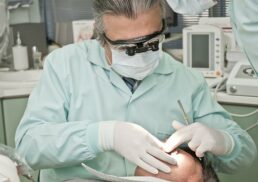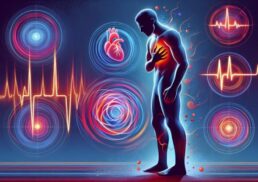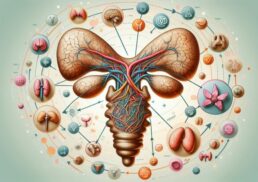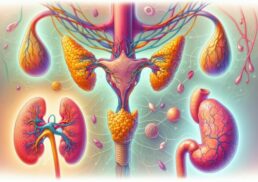Did you know that the testosterone hormone, often referred to as the “male hormone,” plays a crucial role in both men’s and women’s health? It is vital for maintaining muscle mass, energy levels, and even mood regulation. But what causes our testosterone hormone levels to fluctuate, and how can we ensure they remain within a healthy range? This comprehensive guide will explore the functions of testosterone hormone in the body, factors affecting its levels, how it’s measured, and the risks and controversies surrounding testosterone therapy. Get ready to embark on an educational journey that will provide a deeper understanding of this essential hormone.
Table of Contents
Short Summary
Testosterone plays an important role in the body, contributing to secondary sex characteristics, muscle strength and brain function.
Medical conditions and lifestyle factors can affect testosterone levels. Age-related decline is a natural part of aging that may be managed with interventions.
Testosterone therapy carries potential risks such as side effects and prostate cancer concerns which must be carefully considered before undergoing treatment.
The Role of Testosterone in the Body
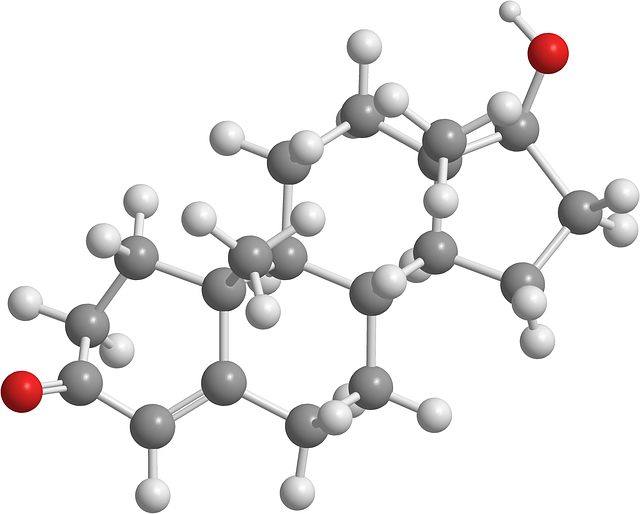
Testosterone is an important hormone for both men and women, responsible for a variety of vital functions in the body. In men, it is the primary hormone responsible for the development of secondary sexual characteristics, such as facial and body hair, muscle strength, and sperm production. Women also produce testosterone in smaller amounts in their ovaries and adrenal glands, where it contributes to normal brain function and other roles. Follicle stimulating hormone plays a role in regulating the production of testosterone in both genders.
But did you know that there might be undiscovered functions of testosterone that could impact our health in ways we are not yet aware of? Let’s dive deeper into the role of testosterone in men and women.
Testosterone in Men
Testosterone, produced in the testicles, is the primary male sex hormone responsible for various functions in men’s bodies. It plays a crucial role in the development of male features such as body and facial hair, a deeper voice, and muscle strength during puberty. Additionally, testosterone is essential for sperm production in adult men.
The body has a carefully designed process to maintain balance of hormones in the blood. This process is known as a “feedback loop”. The brain monitors testosterone levels in the body. If these levels rise too high, signals are sent to the pituitary gland to reduce production. This ensures a delicate balance is maintained.
Testosterone in Women
Although testosterone is often referred to as a male hormone, it also plays an important role in women’s health. In women, testosterone is produced in the ovaries and adrenal glands and contributes to regular brain function and other roles. Ailments of the pituitary, hypothalamus, or adrenal glands, as well as removal of the ovaries, can lead to testosterone deficiency in females.
The balance between testosterone and estrogen is essential for the ovaries to function properly, and conditions like polycystic ovary syndrome (PCOS) can cause elevated levels of testosterone in women.
Lesser-Known Functions of Testosterone
While the known functions of testosterone are well-established, there might be undiscovered roles this hormone plays in our bodies. Some conditions, such as Androgen Insensitivity Syndrome (AIS), affect male fetuses during development and can have significant consequences.
Understanding these lesser-known functions of testosterone could potentially lead to new treatments and therapies for various health conditions. This highlights the need for further research into the complex world of hormones and their impact on our overall health.
Factors Affecting Testosterone Levels

Testosterone levels can be influenced by various factors, such as age, lifestyle, and medical conditions or diseases. As we age, our testosterone levels naturally decline, which can lead to symptoms of low testosterone.
Lifestyle factors like diet, exercise, and stress also play a significant role in determining our testosterone levels. In addition, certain medical conditions and diseases, such as hypogonadism, can impact our testosterone levels.
Let’s explore these factors in more detail to understand how they affect our hormone levels.
Age-Related Decline in Testosterone
Testosterone levels naturally decline with age, starting around the age of 30. This decline is a normal part of the aging process and can lead to symptoms such as decreased libido, erectile dysfunction, fatigue, and irritability.
While age-related decline in testosterone is common, it’s essential to recognize that everyone’s experience will differ. Some individuals may experience a more significant decline, while others may maintain relatively stable levels throughout their lives.
Understanding this natural decline can help individuals and healthcare professionals make informed decisions about potential treatments and interventions.
Lifestyle Factors
Our lifestyle choices can significantly impact our testosterone levels. Factors such as weight, diet, sleep, stress, and alcohol consumption can all affect hormone levels. For example, being overweight or obese, having an unhealthy diet, and leading a sedentary lifestyle can lower testosterone levels by diminishing the body’s capacity to generate the hormone.
On the other hand, weight loss, a healthy diet, and physical activity can help increase testosterone levels by improving the body’s ability to produce the hormone. Making positive lifestyle changes can be an effective way to maintain or improve testosterone levels without medical intervention.
Medical Conditions and Diseases
Certain medical conditions and diseases can cause abnormal testosterone levels in both men and women. Conditions such as hypopituitarism, inflammatory diseases, and hypogonadism can lead to low testosterone levels. On the other hand, conditions like polycystic ovary syndrome, adrenal disorders, and tumors in the adrenal glands or testes can result in high testosterone levels.
Understanding the relationship between these medical conditions and testosterone levels is essential for proper diagnosis and treatment. If you suspect that a medical condition may be affecting your hormone levels, it’s crucial to consult with a healthcare professional for evaluation and guidance.
Measuring Testosterone: Blood Tests and Normal Ranges
A blood test is commonly used to measure testosterone levels, with results varying based on test type and lab. This test provides valuable information on hormone levels, which can help healthcare professionals diagnose and treat potential issues related to testosterone deficiency or excess.
Interpreting test results requires a thorough discussion with a healthcare provider, as normal ranges can vary based on factors such as age and sex. In the following sections, we’ll explore the different types of testosterone tests and how to interpret their results.
Types of Testosterone Tests
There are various types of testosterone tests available, depending on the suspected irregularity. A total testosterone test measures the amount of testosterone present in the blood, both bound and unbound. A free testosterone test, on the other hand, measures only the amount of unbound testosterone in the bloodstream.
Additionally, other tests can measure specific markers in the body, such as sex hormone-binding globulin (SHBG) or testosterone-estradiol binding globulin (TeBG). These tests can provide a more comprehensive understanding of an individual’s hormone levels and help healthcare professionals develop a targeted treatment plan.
Interpreting Test Results
Interpreting testosterone test results requires a discussion with a healthcare provider, as normal testosterone levels can vary. For males, a typical level of testosterone is 300 to 1,000 nanograms per deciliter (ng/dL), while for females, it is typically 15 to 70 ng/dL.
It’s essential to consider factors such as age, sex, and overall health when interpreting test results and making decisions about potential treatments or interventions.
If you have concerns about your testosterone levels, be sure to consult with your healthcare provider for guidance and support.
High Testosterone: Causes, Symptoms, and Treatments
High testosterone levels can be caused by various factors, leading to different symptoms and requiring specific treatments. In some cases, high testosterone may be due to medical conditions, medications, or lifestyle factors, while in others, it may occur naturally. Understanding the causes of high testosterone levels can help individuals and healthcare professionals develop targeted treatments to address the underlying issue.
In the following sections, we’ll explore the causes, symptoms, and potential treatments for high testosterone levels.
Causes of High Testosterone
The potential causes of high testosterone levels can vary depending on factors such as sex and age. In women, common causes of elevated testosterone levels include hirsutism, polycystic ovary syndrome, and congenital adrenal hyperplasia. In men, frequent causes of high testosterone levels are anabolic-androgenic steroid use, genetics, and tumors of the adrenal glands or testes.
Understanding the potential causes of high testosterone is crucial for proper diagnosis and treatment.
Symptoms and Effects
Symptoms of high testosterone can vary based on factors such as sex and age. Physical manifestations may include increased body hair, acne, a deeper voice, and increased muscle mass. Emotional symptoms may include irritability and mood swings, while sexual health changes may include heightened libido and alterations in breast size.
Recognizing the symptoms of high testosterone can help individuals and healthcare professionals identify potential issues and develop appropriate treatment plans.
Treatment Options
Treatment options for high testosterone depend on the underlying cause and may include medication or lifestyle changes. For example, treatments for medical conditions causing high testosterone may involve medications such as glucocorticosteroids, metformin, oral contraceptives, or spironolactone.
Lifestyle modifications, such as weight loss and exercise, may also be beneficial in managing high testosterone levels. It’s essential to work closely with a healthcare professional to determine the most appropriate treatment plan based on individual needs and circumstances.
Low Testosterone: Causes, Symptoms, and Treatments
Low testosterone levels can result from various causes, leading to different symptoms and requiring specific treatments. In some cases, low testosterone may be due to age-related decline, medical conditions, or lifestyle factors, while in others, it may occur naturally. Understanding the causes of low testosterone levels can help individuals and healthcare professionals develop targeted treatments to address the underlying issue.
In the following sections, we’ll explore the causes, symptoms, and potential treatments for low testosterone levels.
Causes of Low Testosterone
Low testosterone levels can be caused by various factors, such as age-related decline, medical conditions like male hypogonadism, or lifestyle factors. Testosterone levels naturally decline with age, typically beginning around the age of 30. Medical conditions such as Klinefelter syndrome and hemochromatosis can also contribute to low testosterone levels.
Lifestyle factors, such as obesity and poor diet, can also impact testosterone production. Understanding the potential causes of low testosterone is crucial for proper diagnosis and treatment.
Symptoms and Effects
Symptoms of low testosterone differ from person to person. Factors such as sex and age impact the type and intensity of the symptoms experienced. Physical manifestations may include decreased muscle and bone mass, hair loss, and fatigue. Emotional symptoms may include irritability, depression, and mood swings, while sexual health changes may include decreased libido and erectile dysfunction.
Recognizing the symptoms of low testosterone can help individuals and healthcare professionals identify potential issues and develop appropriate treatment plans.
Treatment Options
Treatment options for low testosterone depend on the underlying cause and may include testosterone therapy or lifestyle changes. Testosterone replacement therapy is a treatment that can take the form of injections, pellets, patches, or gels and is intended to address the signs and symptoms of low testosterone in men with hypogonadism.
Lifestyle changes, such as diet and exercise, can also help improve testosterone levels. It’s essential to work closely with a healthcare professional to determine the most appropriate treatment plan based on individual needs and circumstances.
Learn more, visit What are the symptoms of low testosterone, and how to increase it.
Risks and Controversies Surrounding Testosterone Therapy
Testosterone therapy has potential risks and controversies, including side effects, prostate cancer concerns, and debates on who should receive treatment. While testosterone therapy may help alleviate symptoms of low testosterone, it’s essential to weigh the potential benefits and risks before undergoing treatment.
In the following sections, we’ll explore the potential side effects, the relationship between testosterone therapy and prostate cancer, and the ongoing debates surrounding who should receive treatment.
Potential Side Effects
Potential side effects of testosterone therapy include cardiovascular problems and high red blood cell counts. Acne, swelling or tenderness of breasts, oily skin, and a reduction in sperm count are also potential side effects. In rare cases, testosterone therapy can cause serious prostate disorders.
It’s essential to discuss the potential side effects with a healthcare professional and carefully consider the potential benefits and risks of testosterone therapy before deciding to pursue treatment.
Testosterone Therapy and Prostate Cancer
Testosterone therapy may stimulate prostate cancer growth, raising concerns for patients with a history of the disease. While it is not established that testosterone therapy directly causes prostate cancer, it is possible that it may accelerate the growth of existing prostate cancer.
Patients with a history of prostate cancer should be mindful of the potential risks associated with testosterone therapy, including a heightened risk of prostate cancer recurrence or advancement. It is essential to monitor the prostate gland during treatment. Options for prostate cancer patients include lifestyle changes, medications, and surgery.
Debates on Who Should Receive Treatment
Debates on who should receive testosterone therapy revolve around the efficacy and necessity of treatment for certain individuals. For example, it is not recommended to treat normal aging with testosterone therapy.
However, postmenopausal women who have low testosterone levels and symptoms that may be attributed to testosterone deficiency may benefit from testosterone treatment. Ultimately, the decision to pursue treatment should be based on a careful evaluation of the potential benefits and risks of therapy, as well as a thorough discussion with a healthcare professional.
Anabolic Steroids vs. Natural Testosterone
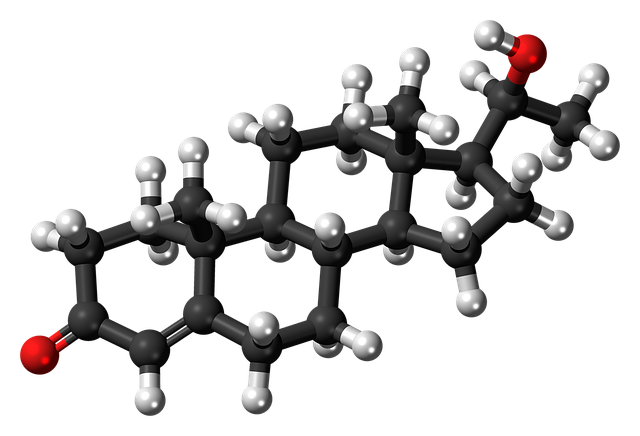
Anabolic steroids are synthetic forms of testosterone that carry risks and ethical considerations compared to natural testosterone. These substances are often misused by athletes and bodybuilders to enhance performance and alter physical appearance, but their use can lead to dangerous health problems.
In the following sections, we’ll explore the differences between anabolic steroids and natural testosterone, as well as the risks, side effects, and ethical considerations surrounding the use of these substances.
What Are Anabolic Steroids?
Anabolic steroids are lab-created versions of testosterone, designed to replicate the effects of the hormone in the body. These substances are often misused by athletes and bodybuilders to enhance performance and alter physical appearance, leading to dangerous health problems. Side effects of anabolic steroid use can include liver damage, high blood pressure, and an elevated risk of heart attack and stroke.
The use of anabolic steroids is not only dangerous but also considered illegal and unethical in many sports organizations and countries.
Risks and Side Effects of Synthetic Testosterone
Risks and side effects of synthetic testosterone, or anabolic steroids, can include physical, emotional, and behavioral changes, as well as potential long-term health issues. Physical changes may include increased body fat, reduced muscle bulk and strength, and decreased bone density. Emotional symptoms may include irritability, mood swings, and depression, while sexual health changes may include heightened libido and alterations in breast size.
In addition to these side effects, synthetic testosterone can also result in serious health risks, such as blood clots, stroke, and an increased risk of prostate cancer.
Legal and Ethical Considerations
The legal and ethical considerations surrounding anabolic steroids involve their use in sports and potential abuse. Anabolic steroids are classified as controlled substances under the Controlled Substances Act, and their use in sports is deemed to be a form of cheating, which can result in penalties or bans.
Ethically, there are implications of the unfair advantage gained by athletes who use steroids, the potential harm to their health, and the negative effect on society, specifically children who view athletes as role models.
It’s crucial to consider the legal and ethical ramifications of anabolic steroid use before deciding to pursue this dangerous path.
Summary
In conclusion, testosterone is a vital hormone that plays a crucial role in both men’s and women’s health. Understanding the factors that can impact testosterone levels, as well as the potential risks and benefits associated with testosterone therapy, is essential for maintaining overall health and wellbeing. By staying informed about the latest research and developments in the field of hormones and working closely with healthcare professionals, individuals can make informed decisions about their hormone health and lead healthier, happier lives.
Frequently Asked Questions
What happens when testosterone hormone is low?
Low testosterone levels can lead to anemia and fatigue, as well as decreased muscle mass, lowered libido, ED, and mood changes.
As such, it is important to recognize the signs of low testosterone and consult a doctor for proper diagnosis and treatment.
How can I increase testosterone hormone?
To increase testosterone hormone, maintain an ideal body weight, exercise regularly, get plenty of sleep, avoid tobacco and alcohol products, and reduce stress.
Additionally, address any underlying medical conditions.
What happens to your body on testosterone?
Testosterone increases skin thickness and oil production, enlarges pores, changes sweat and urine odor, and increases overall sweating.
What symptoms can low testosterone cause?
Low testosterone can cause symptoms such as reduced libido, fatigue, decreased muscle mass and strength, increased body fat, and reduced bone mass.
These symptoms can have a significant impact on a person’s quality of life, and can even lead to depression and other mental health issues.
Fortunately, there are treatments available to help manage the symptoms of low testosterone.
What is the primary function of testosterone in men?
Testosterone is an essential hormone in men, responsible for the development of male physical characteristics such as facial and body hair, a deeper voice, increased muscle strength, and sperm production.
It plays a key role in the development of male reproductive tissues such as the testis and prostate, as well as promoting secondary sexual characteristics such as increased muscle mass and bone mass.
Testosterone levels in men are regulated by the hypothalamus and the pituitary gland.
